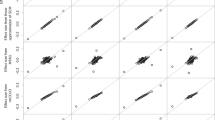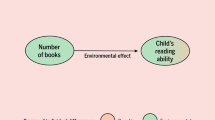Abstract
In this study, we demonstrate the complexities of performing a sibling analysis with a re-examination of associations between cell phone exposures and behavioral problems observed previously in the Danish National Birth Cohort. Children (52,680; including 5441 siblings) followed up to age 7 were included. We examined differences in exposures and behavioral problems between siblings and non-siblings and by birth order and birth year. We estimated associations between cell phone exposures and behavioral problems while accounting for the random family effect among siblings. The association of behavioral problems with both prenatal and postnatal exposure differed between siblings (odds ratio (OR): 1.07; 95% confidence interval (CI): 0.69–1.66) and non-siblings (OR: 1.54; 95% CI: 1.36–1.74) and within siblings by birth order; the association was strongest for first-born siblings (OR: 1.72; 95% CI: 0.86–3.42) and negative for later-born siblings (OR: 0.63; 95% CI: 0.31–1.25), which may be because of increases in cell phone use with later birth year. Sibling analysis can be a powerful tool for (partially) accounting for confounding by invariant unmeasured within-family factors, but it cannot account for uncontrolled confounding by varying family-level factors, such as those that vary with time and birth order.
This is a preview of subscription content, access via your institution
Access options
Subscribe to this journal
Receive 6 print issues and online access
$259.00 per year
only $43.17 per issue
Buy this article
- Purchase on Springer Link
- Instant access to full article PDF
Prices may be subject to local taxes which are calculated during checkout


Similar content being viewed by others
References
Abramson MJ, Benke GP, Dimitriadis C, Inyang IO, Sim MR, Wolfe RS et al. Mobile telephone use is associated with changes in cognitive function in young adolescents. Bioelectromagnetics 2009; 30: 678–686.
Thomas S, Heinrich S, von Kries R, Radon K . Exposure to radio-frequency electromagnetic fields and behavioural problems in Bavarian children and adolescents. Eur J Epidemiol 2010; 25: 135–141.
Byun YH, Ha M, Kwon HJ, Hong YC, Leem JH, Sakong J et al. Mobile phone use, blood lead levels, and attention deficit hyperactivity symptoms in children: a longitudinal study. PLoS One 2013; 8: e59742.
Guxens M, van Eijsden M, Vermeulen R, Loomans E, Vrijkotte TG, Komhout H et al. Maternal cell phone and cordless phone use during pregnancy and behaviour problems in 5-year-old children. J Epidemiol Community Health 2013; 67: 432–438.
Divan HA, Kheifets L, Obel C, Olsen J . Prenatal and postnatal exposure to cell phone use and behavioral problems in children. Epidemiology 2008; 19: 523–529.
Divan HA, Kheifets L, Obel C, Olsen J . Cell phone use and behavioural problems in young children. J Epidemiol Community Health 2012; 66: 524–529.
Goodman R . The Strengths and Difficulties Questionnaire: a research note. J Child Psychol Psychiatry 1997; 38: 581–586.
Gilman SE, Gardener H, Buka SL . Maternal smoking during pregnancy and children's cognitive and physical development: a causal risk factor? Am J Epidemiol 2008; 168: 522–531.
Susser E, Eide MG, Begg M . Invited commentary: the use of sibship studies to detect familial confounding. Am J Epidemiol 2010; 172: 537–539.
Obel C, Olsen J, Henriksen TB, Rodriguez A, Järvelin MR, Moilanen I et al. Is maternal smoking during pregnancy a risk factor for hyperkinetic disorder?—Findings from a sibling design. Int J Epidemiol 2011; 40: 338–345.
Shrader WK, Leventhal T . Birth order of children and parental report of problems. Child Dev 1968; 39: 1165–1175.
Krombholz H . Physical performance in relation to age, sex, birth order, social class, and sports activities of preschool children. Percept Mot Skills 2006; 102: 477–484.
Lawson DW, Mace R . Siblings and childhood mental health: evidence for a later-born advantage. Soc Sci Med 2010; 70: 2061–2069.
Olsen J, Melbye M, Olsen SF, Sørensen TI, Aaby P, Andersen AM et al. The Danish National Birth Cohort—its background, structure and aim. Scand J Public Health 2001; 29: 300–307.
Statens Serum Institut. 7-Year Follow up. Copenhagen. 2010. http://www.ssi.dk/English/RandD/Epidemiology/DNBC/For%20researchers/Data%20available/7-year%20follow%20up.aspx . Accessed 6 September 2011.
Youth in mind. Information for researchers and professionals about the Strengths & Difficulties Questionnaires. http://www.sdqinfo.org/ . Accessed 2 December 2010.
Knudsen LB, Olsen J . The Danish Medical Birth Registry. Dan Med Bull 1998; 45: 320–323.
Mc Colluch CE, Searle SR, Neuhaus JM . Generalized, Linear, and Mixed Models (Wiley Series in Probability and Statistics) 2nd Edition, John Wiley & Sons, Inc.: Hoboken, New Jersey. 2008.
International Telecommunication Union. ITU sees 5 billion mobile subscriptions globally in 2010 2010. http://www.itu.int/net/pressoffice/press_releases/2010/06.aspx . Accessed 24 February 2010.
Gati A, Hadjem A, Wong MF, Wiart J . Exposure induced by WCDMA mobiles phones in operating networks. Ieee T Wirel Commun 2009; 8: 5723–5727.
Kelsh MA, Shum M, Sheppard AR, McNeely M, Kuster N, Lau E et al. Measured radiofrequency exposure during various mobile-phone use scenarios. J Expo Sci Env Epid 2011; 21: 343–354.
Rice F, Lewis A, Harold G, van den Bree M, Boivin J, Hay DF et al. Agreement between maternal report and antenatal records for a range of pre and peri-natal factors: the influence of maternal and child characteristics. Early Hum Dev 2007; 83: 497–504.
Hensley Alford SM, Lappin RE, Peterson L, Johnson CC . Pregnancy associated smoking behavior and six year postpartum recall. Matern Child Health J 2009; 13: 865–872.
Greene N, Greenland S, Olsen J, Nohr EA . Estimating bias from loss to follow-up in the Danish National Birth Cohort. Epidemiology 2011; 22: 815–822.
Mezei G, Benyi M, Muller A . Mobile phone ownership and use among school children in three Hungarian cities. Bioelectromagnetics 2007; 28: 309–315.
Koivusilta LK, Lintonen TP, Rimpela AH . Orientations in adolescent use of information and communication technology: a digital divide by sociodemographic background, educational career, and health. Scand J Public Health 2007; 35: 95–103.
Bohler E, Schuz J . Cellular telephone use among primary school children in Germany. Eur J Epidemiol 2004; 19: 1043–1050.
Soderqvist F, Hardell L, Carlberg M, Hansson Mild K . Ownership and use of wireless telephones: a population-based study of Swedish children aged 7-14 years. BMC Public Health 2007; 7: 105.
Thomas S, Heinrich S, Kuhnlein A, Radon K . The association between socioeconomic status and exposure to mobile telecommunication networks in children and adolescents. Bioelectromagnetics 2010; 31: 20–27.
Acknowledgements
We thank the coordinator of data collection Inge Kristine Meder, data analysts Inge Eisensee and Lone Fredslund Møller, and the participating mothers. This work was supported by the Lundbeck Foundation (Grant number 195/04); the Danish Medical Research Council (Grant number SSVF 0646); and the National Institutes of Health/National Institute of Environmental Health Sciences (Grant number R21ES016831); Vani career grant from the Netherlands Organization for Scientific Research (NWO) to OAA (Grant number 916.96.059).
Author information
Authors and Affiliations
Corresponding author
Ethics declarations
Competing interests
The authors declare no conflict of interest.
Rights and permissions
About this article
Cite this article
Sudan, M., Kheifets, L., Arah, O. et al. Complexities of sibling analysis when exposures and outcomes change with time and birth order. J Expo Sci Environ Epidemiol 24, 482–488 (2014). https://doi.org/10.1038/jes.2013.56
Received:
Revised:
Accepted:
Published:
Issue Date:
DOI: https://doi.org/10.1038/jes.2013.56
Keywords
This article is cited by
-
Birth order and pediatric traumatic brain injury
Scientific Reports (2022)
-
Trends in cell phone use among children in the Danish national birth cohort at ages 7 and 11 years
Journal of Exposure Science & Environmental Epidemiology (2016)



